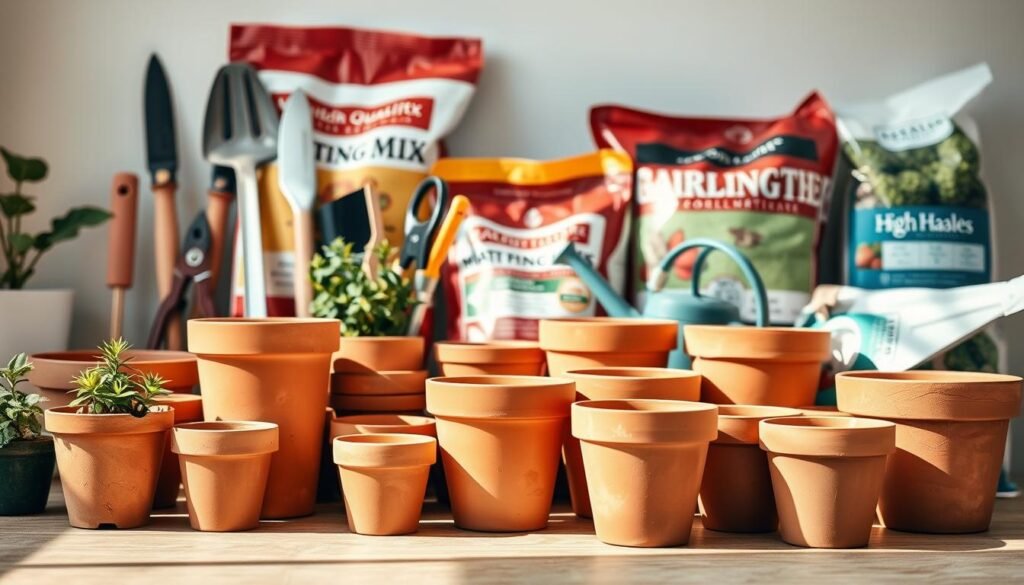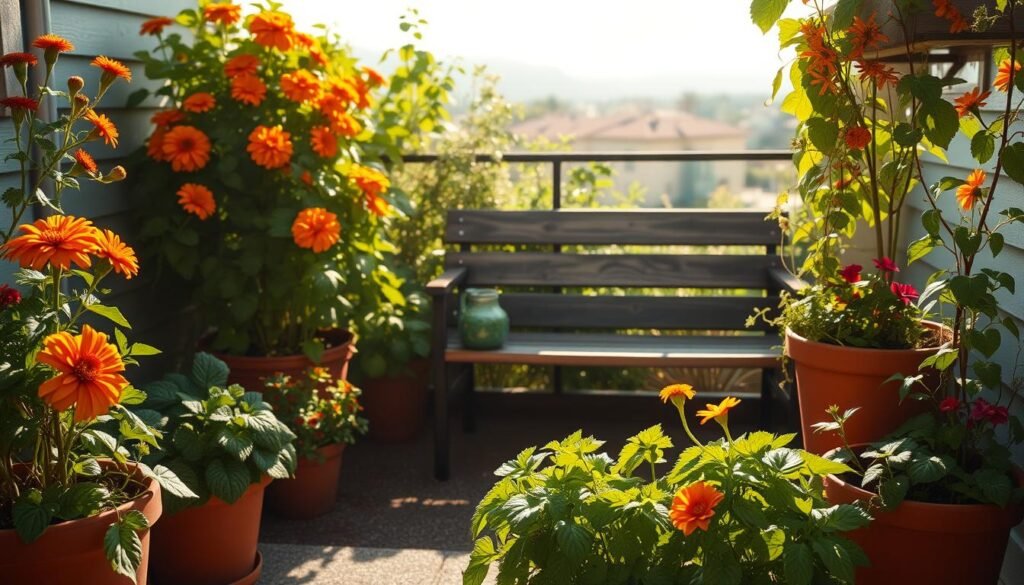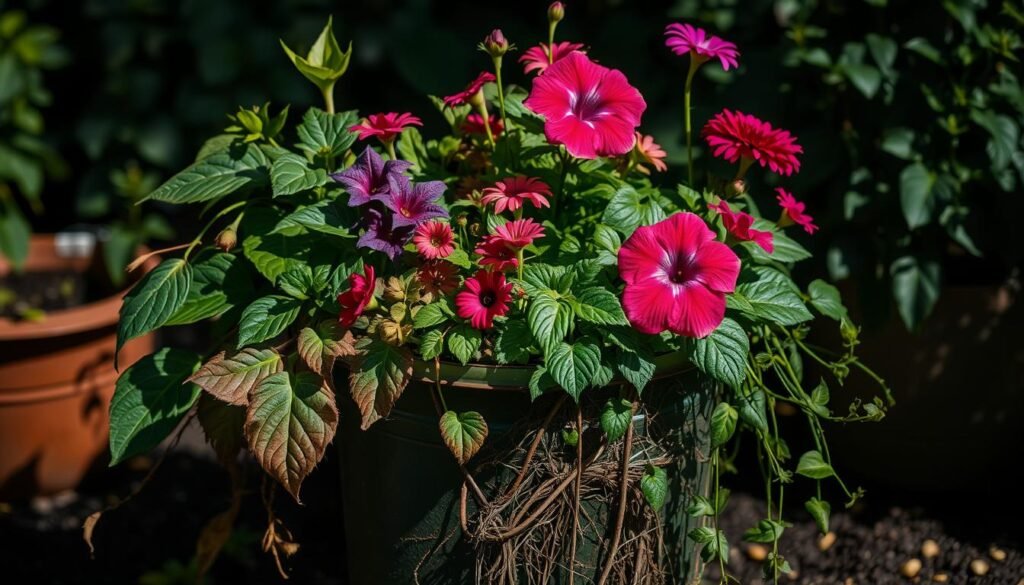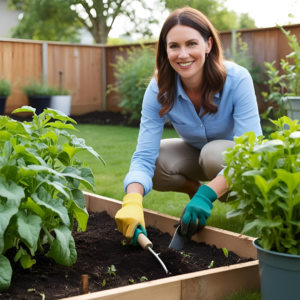Did you know that over 30% of U.S. households grow their own food? Many of these gardeners are turning to containers and pots to make the most of limited space. This bucket gardening guide will cover everything you need to know to get started
I began my journey with container gardening a few years ago, and it completely transformed how I approach growing edibles. Repurposed buckets and pots not only save space but also allow me to control the soil and environment for healthier plants. Plus, it’s a sustainable way to reuse materials and reduce waste.
In this guide, I’ll walk you through everything you need to know, from choosing the right containers to managing soil and watering. Whether you’re a beginner or an experienced gardener, this approach fits perfectly into modern trends, making it easier than ever to grow your own food.
Key Takeaways
- Containers and pots are ideal for gardening in small spaces.
- Repurposed materials like buckets can make gardening sustainable.
- Container gardening allows better control over soil and plant health.
- This method suits both beginners and experienced gardeners.
- Modern trends emphasize flexibility and accessibility in gardening.
Introduction to Bucket Gardening
Container gardening is a game-changer for urban living. It’s a simple yet effective way to grow fresh produce, even in the smallest spaces. Whether you’re a beginner or have some experience, this is an excellent original gardening idea.
What Is Bucket Gardening?
Bucket gardening involves using containers like plastic buckets or grow bags to cultivate plants. It’s perfect for those with limited space, such as apartments or small backyards. This approach allows you to control the soil and environment, ensuring healthier plants.
One tip for beginners is to check the previous contents of plastic containers. If they held non-food chemicals, clean them thoroughly to ensure they’re safe for growing food at home.
Benefits of Growing in Small Spaces
Growing in containers saves space and reduces soil compaction. It also limits pest issues, making it easier to maintain a thriving garden. Plastic buckets and grow bags are cost-effective solutions for beginners.
Proper garden water management is crucial. Containers dry out faster than traditional gardens, so regular watering is essential. Using larger containers can help retain moisture longer, protecting plants from temperature fluctuations.
This method is not only practical but also sustainable. Repurposing materials like plastic buckets reduces waste and promotes eco-friendly practices. Whether you’re growing herbs, vegetables, or flowers, container gardening offers endless possibilities.
Essential Containers and Potting Mix for Success
The foundation of a thriving container garden lies in the right materials. Choosing the right containers and soil ensures your plants grow healthy and strong. Let’s dive into the essentials for success.

Selecting Safe Buckets and Containers
When picking containers, safety is key. Always check what the container held before. If it stored chemicals, clean it thoroughly to avoid harming your plants. Plastic containers are popular, but ensure they’re food-safe.
Here’s a quick comparison of container types:
| Container Type | Pros | Cons |
|---|---|---|
| Plastic Pots | Lightweight, affordable, versatile | Can degrade over time |
| Glazed Clay Pots | Retains moisture, durable | Heavier, more expensive |
| Grow Bags | Cheap, breathable, portable | Less durable, dries out quickly |
The Importance of Drainage and Quality Soil
Proper drainage is crucial. Without it, plants can suffer from root rot. Always drill holes in the bottom of your containers to let excess water escape. This simple step keeps your plants healthy.
Soil quality matters just as much. Even if you’re working on a balcony garden idea. Regular garden soil is too dense for containers. Instead, use a high-quality potting mix. It’s lighter and provides better aeration for roots. Adding compost can boost nutrients and improve soil structure.
“Healthy soil is the heart of a thriving garden. Invest in quality potting mix, and your plants will thank you.”
Here are some quick tips for success:
- Use containers at least 12 inches in diameter for most vegetables.
- Mix compost into your potting soil for added nutrients.
- Check drainage holes regularly to ensure they’re not clogged.
By focusing on safe containers and quality soil, you’ll set your garden up for success. These basics are the building blocks of a thriving container garden.
My Bucket Gardening Guide: Personal Tips and Techniques
Starting my container garden taught me the importance of preparation. Over the years, I’ve developed a routine that ensures my plants thrive from the very beginning. Here, I’ll share my personal tips and techniques to help you get started with confidence.
How I Prepare My Containers for Planting
Before planting, I always prepare my containers carefully. First, I clean them thoroughly, especially if they’ve held non-food items. This step prevents harmful chemicals from affecting my plants. Next, I check for proper drainage. Without it, roots can rot, and plants won’t grow well.

Here’s my checklist for prepping containers:
- Clean the container with soap and water.
- Drill drainage holes if none exist.
- Add a layer of gravel or broken pottery at the bottom.
- Fill with high-quality potting mix.
Step-by-Step Process to Get Started
Once my containers are ready, I follow a simple process to plant grow successfully. First, I choose the right size container for each plant. Larger garden flower containers are better for vegetables, as they give roots more space to spread. I also ensure the soil is loose and nutrient-rich.
Here’s my step-by-step guide:
- Select a container at least 12 inches in diameter.
- Fill it with potting mix, leaving room for the plant.
- Plant seeds or transplants at the recommended depth.
- Water thoroughly and place in a sunny spot.
I manage one container at a time, experimenting with different varieties each season. This approach helps me learn what works best in my space. For example, I’ve found that herbs like basil and thyme grow well in smaller containers, while tomatoes need more room.
“Preparation is the foundation of a healthy garden. Take the time to set up your containers correctly, and your plants will reward you.”
One common pitfall I’ve encountered is overwatering. Containers dry out faster than traditional gardens, but too much water can harm roots. I’ve learned to check the soil moisture regularly and adjust my watering schedule based on the season.
By following these tips, you can kickstart your own container garden with confidence. Whether you’re growing herbs, vegetables, or flowers, proper preparation ensures a successful and rewarding experience.
Growing a Variety of Vegetables and Herbs in Buckets
Growing your own food in containers opens up endless possibilities, even in the smallest spaces. Whether you’re cultivating tomatoes, peppers, or fresh herbs, this method allows you to enjoy a diverse harvest. Let’s explore how to grow popular crops and create a thriving container garden.

Popular Crops: Tomatoes, Peppers, and Eggplant
Tomatoes are a favorite for container gardening. Varieties like ‘Early Girl’ and ‘Patio’ thrive in 5-gallon pots. They need plenty of sunlight and regular watering to produce juicy fruits. Peppers, such as bell and chili types, also do well in containers. A 3-gallon pot is ideal for each plant.
Eggplants, like ‘Black Beauty,’ require slightly larger containers due to their size. A 5-gallon pot works best to support their growth. These crops benefit from nutrient-rich soil and consistent care. With proper attention, you can enjoy a bountiful harvest all season long.
Adding Herbs, Lettuce, and More to Your Garden
Herbs like basil, thyme, and parsley are perfect for smaller containers. They add flavor to your meals and are easy to grow. Lettuce, such as ‘Ruby’ and ‘Salad Bowl,’ thrives in shallow pots. These leafy greens are ideal for quick harvests and continuous planting.
For a diverse garden, consider adding beans and cucumbers. Bush beans like ‘Blue Lake’ grow well in 5-gallon pots, while cucumbers need at least a 1-gallon container. These vegetables are great for maximizing space and adding variety to your meals.
“Container gardening lets you experiment with different crops, making it a fun and rewarding experience.”
Here are some tips for success:
- Choose the right container size for each crop.
- Use high-quality potting mix and ensure proper drainage.
- Monitor water and nutrient needs regularly.
- Group compatible plants together to save space.
By growing a mix of vegetables and herbs, you can create a vibrant and productive garden. Whether you’re a beginner or an experienced gardener, container gardening offers flexibility and endless possibilities.
Container Gardening Strategies for Small Spaces
Small spaces don’t have to limit your green thumb—container gardening makes it possible to grow thriving plants almost anywhere. Whether you’re working with a sunny window, a small patio, or a balcony, a few smart strategies can help you maximize your space and resources. Let’s dive into how to make the most of sunlight and manage watering effectively.

Maximizing Sunlight for Healthy Growth
Sunlight is crucial for plant growth, and positioning your containers correctly can make all the difference. Place them near a south-facing window or on a patio where they’ll get at least 6 hours of direct sunlight daily. For plants that need less sun, like herbs and leafy greens, a spot with 3-5 hours of light works well.
Reflective surfaces, such as white walls or mirrors, can amplify sunlight. If your space lacks natural light, consider using grow lights to supplement. Rearranging containers throughout the season can also help you take advantage of shifting sunlight patterns.
Managing Watering in Confined Spaces
Containers dry out faster than traditional gardens, so consistent watering is key. Check the soil moisture by inserting your finger about an inch deep. If it feels dry, it’s time to water. Using a well-balanced potting mix can improve drainage and retain moisture longer.
Here’s a quick comparison of container types and their sunlight needs:
| Container Type | Sunlight Needs | Best For |
|---|---|---|
| Plastic Pots | 6-8 hours | Vegetables like tomatoes and peppers |
| Glazed Clay Pots | 3-5 hours | Herbs and leafy greens |
| Grow Bags | 6-8 hours | Root vegetables and vining plants |
Supports like trellises or stakes can help plants withstand wind and heavy rainfall. They also save space by encouraging vertical growth. For example, tomatoes and cucumbers benefit greatly from trellises.
“The right container garden type and mix can transform even the smallest space into a thriving green oasis.”
By choosing the right potting mix and container type, you can create a healthy environment for your plants. A mix of compost, sand, and organic materials ensures proper drainage and fertility. Regularly feeding your plants with organic fertilizer keeps them strong and productive.
With these strategies, you can turn any small space into a flourishing container garden. Whether you’re growing herbs, vegetables, or flowers, smart planning and care will yield impressive results.
Avoiding Common Bucket Gardening Pitfalls
Avoiding mistakes is key to a thriving container garden. Over the years, I’ve learned that small oversights can lead to big problems. Let’s explore some common pitfalls and how to steer clear of them.
One of the most critical steps is ensuring proper drainage. Without a hole bottom, water can pool and cause root rot. Always drill holes in your containers to let excess water escape. This simple step can save your plants from unnecessary stress.

Another mistake I’ve seen is improper seed planting. Planting seeds too deep or too close together can stunt growth. Follow the instructions on the seed packet for the best results. Overcrowding can also lead to competition for nutrients and space.
Overwatering is a common issue, especially for new gardeners. Containers dry out faster, but too much water can harm roots. Check the soil moisture regularly by inserting your finger about an inch deep. If it feels dry, it’s time to water.
“A little preparation goes a long way in preventing problems. Take the time to set up your containers correctly, and your plants will thrive.”
Here’s a quick comparison of common mistakes and how to avoid them:
| Mistake | Solution |
|---|---|
| No drainage holes | Drill holes in the hole bottom |
| Overcrowding seeds | Follow spacing guidelines on seed packets |
| Overwatering | Check soil moisture before watering |
As a dedicated gardener, I’ve also learned the importance of checking for toxic residues. If you’re repurposing containers, clean them thoroughly. This ensures they’re safe for growing food. A little extra effort can protect your plants and your health.
By avoiding these common pitfalls, you can enjoy a successful container garden year after year. Whether you’re planting seeds or repurposing containers, careful planning makes all the difference.
Start Growing Your Bucket Garden Today
Transforming small spaces into lush green havens is easier than you think. My journey with container gardening has shown me how versatile and rewarding it can be. Whether you’re working with a patio, balcony, or windowsill, this method lets you grow fresh produce and vibrant plants with ease.
Start by choosing the right planter and soil mix. Proper drainage and nutrient-rich soil are essential for healthy growth. Don’t forget to experiment with herbs like basil or thyme—they’re perfect for beginners and add flavor to your meals.
With a little care, each planter can yield a bountiful harvest. I encourage you to try this approach and share your successes. Overcoming initial challenges is part of the fun, and the results are worth it. Keep exploring and enjoy the creative process of container gardening!
FAQ
What is bucket gardening?
Bucket gardening is a method of growing plants in containers like buckets, pots, or planters. It’s perfect for small spaces like patios or balconies, allowing you to cultivate vegetables, herbs, and flowers without a traditional garden.
Why should I try growing in small spaces?
Growing in small spaces is ideal for urban living or limited areas. It’s efficient, requires less maintenance, and lets you control soil quality and drainage. Plus, it’s a great way to grow fresh food at home.
How do I choose the right container for my plants?
Select containers made of safe materials like plastic, ceramic, or fabric. Ensure they have drainage holes at the bottom to prevent waterlogging. Size matters too—pick one that suits your plant’s root system.
Why is drainage important in container gardening?
Proper drainage prevents root rot by allowing excess water to escape. Always check for holes at the bottom of your container and use a quality potting mix to maintain healthy soil moisture.
What’s the best way to prepare a bucket for planting?
Start by drilling drainage holes in the bottom. Fill it with a mix of potting soil and compost for nutrients. Ensure the container is clean and ready to support your plant’s growth.
Can I grow tomatoes in a bucket?
Absolutely! Tomatoes thrive in containers. Choose a large bucket, provide support like a trellis, and ensure they get plenty of sunlight. Regular watering and fertilizing will yield a healthy crop.
What herbs grow well in containers?
Herbs like basil, parsley, and mint are perfect for containers. They don’t need much space and can grow on a sunny windowsill or patio. Just keep the soil moist and trim them regularly.
How do I maximize sunlight for my container garden?
Place your containers in areas that receive at least 6 hours of sunlight daily. If space is limited, use vertical stands or move pots to follow the sun throughout the day.
What are common mistakes to avoid in bucket gardening?
Overwatering, using poor-quality soil, and neglecting drainage are common pitfalls. Also, ensure your plants have enough space and sunlight to grow. Regular care and attention will keep your garden thriving.

